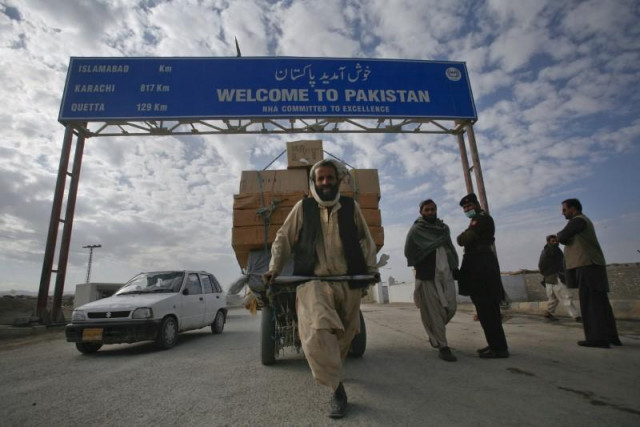Pak-Afghan ties: peace through trade and culture
The populations on both sides have to do with one of the lowest socio-economic indicators in the world

Pakistan-Afghan border. PHOTO: REUTERS
The populations on both sides have to do with one of the lowest socio-economic indicators in the world. At the moment their survival is at stake as they are caught in the middle of blazing guns of the state and the violent non-state actors. There cannot be two views on the fact that both sides stand at a crossroads of history. Their only burning desire is to have peace and fundamental rights.
The most effective way for minimising the existing trust deficit between the two countries is people-to-people contact. In order to bury the past hatchet, we have to be mindful that while forming an opinion, it is imperative to understand that history plays a decisive role in moulding the psyche of a nation. Once this is comprehended, public opinion on both sides can generate pressure over the policymakers to devise people-centric policies focusing on peace which is imperative for international trade. International trade is the best policy option to create capital and further investment for industrial production on both sides of the border.
People are the most important element of a state. Without people, no state can exist. In fact, in today’s world, all organs of the state exist for the good of the people. Issues of governance revolve around the basic premise of a better quality of life by investing in human capital. Human happiness is now the philosophy of the modern state. The emphasis is on development. Development is now no longer used in a narrow sense and is not merely economic growth or an increase in per capita income but a qualitative change covering the whole gamut of the life of a citizen. Cooperation between Pakistan and Afghanistan can act as a catalyst in addressing the recent challenges of poverty, development and terrorism. If this premise is taken as a paramount plank of policy, then all the emphasis would be on peaceful co-existence and respecting each other’s sovereign status. This requires a major paradigm shift at the strategic level.
The trade between Pakistan and Afghanistan has significant geopolitical and economic importance for both countries. Pakistan has remained Afghanistan’s largest trading partner until 2015 when the trade volume totalled around $3 billion. But due to the spike in political tensions, it dwindled to around $8 million. Comprehending and addressing challenges to the Pakistan-Afghan trade will smoothen the way for establishing peace in the region. Both countries are blessed with one of the most beautiful scenic tourist spots. Afghanistan has been bestowed with an abundance of natural resources ranging from minerals worth more than $3 trillion to various regional fruits. Pakistan has not only been bestowed with industries but also with other raw materials. These resources can be best utilised if the Pakistan-Afghan relations evolve along with economic ties.
The regional scenario also offers the best opportunities for trade. In this context, the China- Pakistan Economic Corridor (CPEC) is a pilot project of the Belt and Road Initiative, which is meant to provide a platform for international cooperation to achieve high quality development in the region while connecting 127 countries. The projects underway will develop industry and infrastructure in the first phase, and in the second phase, CPEC will focus on close cooperation and social livelihood. Involvement in minerals, copper, iron, gas and petroleum (Aynak Copper mine and Hajigak Iron ore deposit) are China’s primary interest. With these opportunities in place, Chinese policymakers are also of the view that they would play a positive role in promoting peace and trade between Pakistan and Afghanistan.
Prime Minister Imran Khan’s announcement to keep the Torkham border open for 24 hours was a good step, but the handling of traders and other travellers by the insufficiently-equipped NLC personnel and Afghan forces gave rise to many grievances. Similarly, allowing Afghan refugees with a Proof of Registration to open a bank account has certainly created goodwill.
These ties can be further augmented with the understanding that Pakistan and Afghanistan share poets, writers and philosophers like Jalaluddin Rumi, Hafiz Shirazi, Shah Hussain Hotak, Amanullah Khan, Rumi Balkhi, Allama Iqbal, Rehman Baba, Khushhaal Khan Khattak, Hameed Baba, Abdul Hay Habibi, Hamza Baba, Ghani Khan, Qalander Momand and Sulaiman Laiq. They also share musicians and singers such as Khial Muhammad, Rafiq Shinwari, Nashenas, Rahim Ghamzada, Ustad Shahwali, Qamar Gula, Gulnar Begum, Sardar Ali Takkar, Naghma and Wagma. So with these, new avenues of cultural exchange would further cement our ties of friendship.
The avoidance of war can be done by leading the path of trade and sharing culture. Augmentation of international trade would connect the region into what is a sure recipe for peace.
Published in The Express Tribune, November 20th, 2019.
Like Opinion & Editorial on Facebook, follow @ETOpEd on Twitter to receive all updates on all our daily pieces.














COMMENTS
Comments are moderated and generally will be posted if they are on-topic and not abusive.
For more information, please see our Comments FAQ